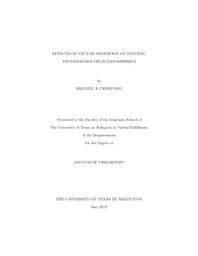
ATTENTION: The works hosted here are being migrated to a new repository that will consolidate resources, improve discoverability, and better show UTA's research impact on the global community. We will update authors as the migration progresses. Please see MavMatrix for more information.
Show simple item record
| dc.contributor.author | Crawford, Britnee A. | en_US |
| dc.date.accessioned | 2012-07-25T19:08:54Z | |
| dc.date.available | 2012-07-25T19:08:54Z | |
| dc.date.issued | 2012-07-25 | |
| dc.date.submitted | January 2012 | en_US |
| dc.identifier.other | DISS-11729 | en_US |
| dc.identifier.uri | http://hdl.handle.net/10106/11064 | |
| dc.description.abstract | Vector-borne diseases have had a major impact on global health concerns since their discovery in the 1800's. A vector-borne disease is one transmitted to human or animal host via an invertebrate vector (usually an insect). Chagas' disease, caused by the parasite Trypanosoma cruzi, is transmitted via insect vectors from the Triatoma family. Although human infection with Chagas' is of importance, the disease is maintained in sylvatic (in the wild) transmission cycles. This study examines the effects of vector migration on the spread of T. cruzi in certain sylvatic cycles in the southeastern U.S. and Mexico from several angles. First, a framework for deriving estimates for migration rates is developed. This framework translates local, small-scale vector dispersal information (extracted from biological studies) into global, largescale migration rates, which can then be used in metapopulation "patch" models or spatially explicit (discrete in space) models. To apply the migration rate derivation framework, a metapopulation compartmental model describing the transmission cycles is presented as a system of ordinary differential equations coupled via migration of the vectors. Standard threshold analysis techniques provide insight into the role of migration through the basic reproductive number, R0, while numerical investigations illustrate migration's effects on prevalence of T. cruzi. Finally, in order to gain a fuller understanding of the spread of T. cruzi in these regions, a spatially explicit model (cellular automaton) is developed with the main goal of measuring invasion speed of the epidemic. Effects on invasion speed and direction of invasion are examined based on certain vector migration characteristics, such as preference for dispersal in a particular direction. When compared with no preference for direction, results show the increase in speed is greater if the preferred direction is more in alignment with the natural geography of the region than the decrease in speed if the preferred direction is not aligned with the natural geography. | en_US |
| dc.description.sponsorship | Kribs, Christopher | en_US |
| dc.language.iso | en | en_US |
| dc.publisher | Mathematics | en_US |
| dc.title | Effects Of Vector Migration On Sylvatic Trypanosoma Cruzi Transmission | en_US |
| dc.type | Ph.D. | en_US |
| dc.contributor.committeeChair | Kribs, Christopher | en_US |
| dc.degree.department | Mathematics | en_US |
| dc.degree.discipline | Mathematics | en_US |
| dc.degree.grantor | University of Texas at Arlington | en_US |
| dc.degree.level | doctoral | en_US |
| dc.degree.name | Ph.D. | en_US |
Files in this item
- Name:
- Crawford_uta_2502D_11729.pdf
- Size:
- 3.000Mb
- Format:
- PDF
This item appears in the following Collection(s)
Show simple item record


